
![]()
Home > Amos Nachoum > Big Animals Expeditions
Snow Leopard Photography Trekking
Ladakh, India
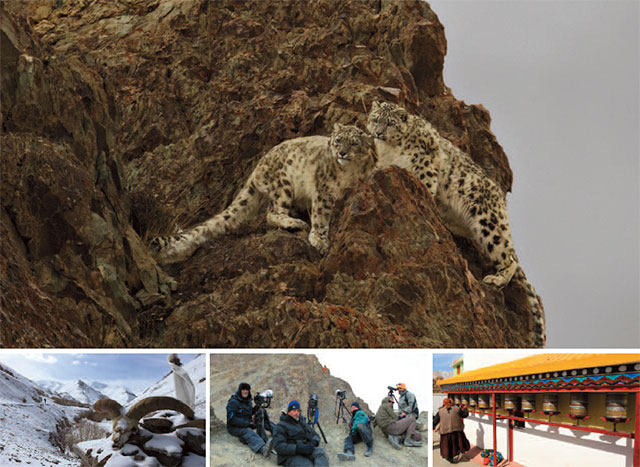
| Snow Leopard Photography Trekking | |
|---|---|
| experience | 3 years |
| where | Ladakh, India |
| max no. of guests | 6 guests |
| expedition leader | Nathaniel Smalley |
| departure | 2016: February 20-March 8 |
| duration | 17 days |
| pricing | $9,800 per person, based on double occupancy |
| activities | Photography, hiking, climbing and exploring |
| temperature | 40F(4C)/sunny to 14F(-10C)/ snow & wind Night: 0F (-18C) to -13F(-25C)/extreme cold & snow |
A rare opportunity to spend time in one of the world’s last truly wild places, in search of a majestic, reclusive animal that only the most adventurous and intrepid will ever have the privilege of seeing in the wild.
Phantom of the Himalayas
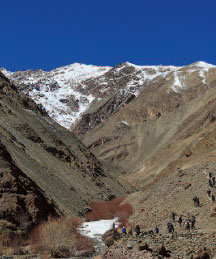 Atop a Himalayan summit in Ladakh located between the states of Jammu and Kashmir in northern India, our journey to photograph snow leopards, a wilderness scene rarely observed much less photographed, was soon to be rewarded.
Atop a Himalayan summit in Ladakh located between the states of Jammu and Kashmir in northern India, our journey to photograph snow leopards, a wilderness scene rarely observed much less photographed, was soon to be rewarded.
After patiently waiting for hours, this Unimaginable encounter, nature's ultimate gift, occurred at the end of a long, strenuous climb to 12,500 feet (3,810 m) and up to 14,000 feet (4,267meter)
Not only were we physically challenged by high elevation; we endured bitter cold and harsh terrain. Snow with gale force winds brought daytime temperatures as low as 14f (-10c) with bone chilling nights dropping to -13 f (-25c). Sunny days brought warmer temperatures of 40 f. For twelve days, we trekked trails covered with packed ice crisscrossing frozen rivers. These conditions required immense endurance and physical conditioning.
The first sighting of a leopard mother tenderly loving her two-year-old cub transfixed us. This was not behavior we expected to observe from such a notorious predator. Later in the day, viewing the female morph into what appeared to be a protective mode further amazed us.
Our wildlife guide quietly motioned toward an adjacent peak. Emerging from his den, a juvenile male stealthily, but with great agility, climbed the steep terrain toward the female. As the cub approached, the female rose. Emitting a deep guttural sound, the call was one of familiarity and acceptance. The young male was her separated cub.
Instantly, she tucked her chin under his strong neck. Nuzzling him, she maternally closed her eyes while he curiously gazed into the distance. We were experiencing a moment frozen in time, the perfect image of love observed between a mother and her cub. The only sound on Himalaya’s rugged mountain peaks was the rapid-fire of camera shutters clicking.
Emotional warmth exhibited by these snow leopards, descendants of the pre-historic saber tooth cat or tiger, stands in stark contrast to their winter environment. The snow leopard’s rarity and beauty attracts a hard-core adventurer capable of experiencing the frigid conditions of the Himalayas.
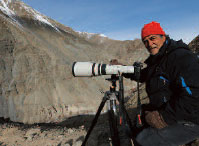 Years of research determined that the best opportunity to observe snow leopards would be during their winter mating season. Based on a few previous sightings, the best destination would prove to be hemis national park located about 12 miles (20 Km) between rumbak and Zinchen villages. The frozen rumbak stream was chosen as our base of operation because it was located between three observation peaks:
Tablung, husing, and khalung. It took us three hours trekking on the solid ice stream before we began the climb to husing observation peak.
Years of research determined that the best opportunity to observe snow leopards would be during their winter mating season. Based on a few previous sightings, the best destination would prove to be hemis national park located about 12 miles (20 Km) between rumbak and Zinchen villages. The frozen rumbak stream was chosen as our base of operation because it was located between three observation peaks:
Tablung, husing, and khalung. It took us three hours trekking on the solid ice stream before we began the climb to husing observation peak.
Credit to our six excellent guides is well deserved. While Gyalson Shangku and Tsering Gurment found the snow leopards we photographed, a pair of guides searched each of the three peaks. Daily at Daybreak, they departed camp to scout the mountain ranges for telltale leopard signs: resting places or paw tracks left from hunting or traveling. The guides communicated with one another using radio transmitters. By 6:00 AM, they will wake you up to get ready for the day scouting – we will not be waiting for the other teams out there to tell us where or if they spot the “ghost cat” – we are aiming to be the first to locate them, that is the adventure and the one for wildlife photographer aspiration. We also receive all the report arriving from the other guides sighting, and they would call us to join them.
Like most predators, snow leopards are active early in the morning and around dusk into the night. We experienced our unique sighting as darkness began to creep over the peak. The air, cold and thin, made It painful to breathe. Someone whispered, “leopards!” We all jumped behind our camera lenses. Fortunately, to accommodate the dimming light, I had changed my iso from 800 to 6,400. A moment like this is a reminder of how precious and inspiring the wilderness can be. If we respect mother nature, the dividends are enormous.
The Endangered Snow Leopard
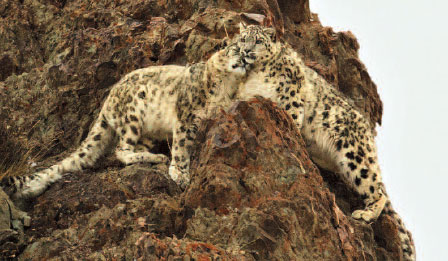 Snow leopards live solitary lives spent regularly patrolling their territory, which often covers hundreds of square miles. Territorial, they leave markings throughout these vast areas: scraping the ground with their paws or spraying urine on rocks.
Snow leopards live solitary lives spent regularly patrolling their territory, which often covers hundreds of square miles. Territorial, they leave markings throughout these vast areas: scraping the ground with their paws or spraying urine on rocks.
Occasionally, they rub against rocks leaving clumps of hair. The snow leopard’s breeding season occurs between December and March. The only large cat that cannot roar, snow leopard vocalizations include hisses, chuffing, mews, growls, and wailing. During mating season a pair will call back and forth to one other by snarling.
The snow leopard is a large cat native to the mountain ranges of central and south asia. It is listed as endangered on the iucn red list of threatened species because as of 2003, the size of the global population was estimated at 4,080 – 6,590 adults, of which fewer than 2,500 individuals may reproduce in the wild. Today their number is estimated ay 3,000 only.
Snow leopards inhabit alpine and subalpine zones at elevations from 3,000 to 4,500 m (9,800 to 14,800 ft.). In the northern range countries, they also occur at lower elevations.
Snow leopards show several adaptations for living in a cold, mountainous environment. Their bodies are stocky, their fur is thick, and their ears are small and rounded, all of which help to minimize heat loss. Their Paws are wide, which distributes their weight better for walking on snow, and have fur on their undersides to increase their grip on steep and unstable surfaces; it also helps to minimize heat loss.
Snow leopards’ tails are long and flexible, helping them to maintain their balance, which is very important in the rocky terrain they inhabit. Their tails are also very thick due to storage of fat and are very thickly covered with fur, which allows them to be used like a blanket to protect their faces when asleep.
Perhaps the snow leopard is only observed when it feels so inclined. During our encounters, these incredible animals seemed well aware of our presence before we ever located them, and they disappeared without a trace whenever they chose to. Perhaps, that is why they are called the phantom of the Himalayas.
General Itinerary
While this itinerary can change, the snow leopard expedition begins in New Delhi. This indian city can be described as a smorgasbord for the senses: vibrant colors, intoxicating smells, baffling traffic, and overwhelming sounds. Before trekking to the 14,000-foot (4,267 meters) thin-air elevation of hemis national park, we acclimated by spending several days in the tibetan-influenced city of Leh, considered the capital of the ancient Himalayan kingdom of Ladakh.
These days are spent visiting local markets and a number of the region's buddhist (hems, thickset and shay) monasteries dating back to the 15th and 16th centuries. On the third morning, after departing Leh by car for the tiny village of zingchen, we crossed the indus river before reaching our destination in hemis national park.
Only two families call zingchen home. For the next ten days your guides gyalson shangku and tsering gurmet then lead our trek into the Himalayas. Each member of the group had an assistant, sherpa helping you to carry your camera with the big lens and tri- pod. During early mornings we searched for the leopards along ridgelines, hoping to observe them returning to their daytime resting place. Unsuccessful, we viewed a flock of chukar partridge or herds of blue sheep. As the leopard’s primary source of food, locating blue sheep in the valley is a good omen.
There are about five key observation points along the river stretch. The guide will choose each morning where to go and the camp team is prepared in sending lunch and hot drinks, much needed energy and warmth during the day to our location that some days can 10-15 miles away from camp.
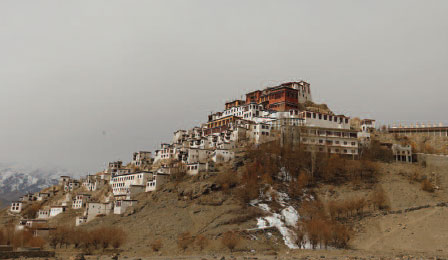
Day 1: Arrive in Delhi, clear customs, and check into hotel. Usually flights in india arrive late at night, hence we will give you time to rest this evening.
Day 2: Wake up at leisure. It is important to adjust to the time change before heading to Leh. A short sightseeing tour will be arranged. If any items need to be bought, this would be the day. Dinner at a local restaurant with briefing.
Day 3: Fly to Leh, the ancient capital of the former Himalayan kingdom of Ladakh. Our local guides will take us to Hotel Omasilla. Spend the day relaxing and acclimating to the altitude (11,500 feet!). Omasilla is a family run hotel. Heating is provided in the room through heaters and hot water bottles. It is essential to start getting used to the cold. We spend the day continuing to get used to the altitude, visiting the local sights such as the ancient buddhist monasteries and the bustling markets around Leh. Return to the Omasilla.
Day 4: Drive to Zinchen, and begin our trek through snow leopard country. Packhorses carry the bulk of our gear, you’ll carry a small day- pack, your binoculars and camera. We’ll spend 2 – 3 hours hiking to our first campsite, a distance of about 5 kilometers (a little over 3 miles). Spend the night in the sleeping bag you brought (it needs to be rated to at least – 25 degrees c). We supply the 2-person private tent to each person. This is hemis national park and we will be in the husing valley.
Day 5-14: We’re now at around 12,500 feet, and we should all feel pretty comfortable hiking around at this height. We’ll trek to nearby valleys and rock formations looking for blue sheep, because the snow leopards are looking for blue sheep, too. The program everyday is not fixed. Everything will depend on weather conditions and snow leopard movements. The idea is to have the best possibility to track the "ghost cat" (snow leopard).
We may move camp, trekking a few hours to the very remote village of rumbak, where snow leopards are known to prey on livestock. Again this will depend on messages coming through passing villagers that may make us aware about sightings. we’ll camp near village, but spend the evening enjoying tibetan hospitality with the locals. there is a possibility we may stay in a homestay.
At camp we have one heated social tent for eating, meeting and generator to charge your camera batteries. At camp you will have limited supply of fresh water for basic hygiene.
A team of sherpa that carry you camera and tripod will support you. Other team is dedicated to bring lunch and hot drink during the day no matter how far we are in search of the leopard.
Day 15: We pack up early morning, load our gear on the mule convoy and set out back by foot for Zinchen 2 – 3 hours hike. At Zinchen you meet your van and driven back to Leh. Rest and take hot bath.
Day 16: We take you to the airport for morning flight to Delhi. All day at leisure in Delhi. A day room has been booked for you. Evening transfer to airport for international flight.
******
Tour price includes:
- 2 nights hotel in New Delhi, single
- 15 nights of mixed accommodation – hotels Leh are based on single accommodation. Camping, private tent for each person.
- 10 days of trekking
- All transfers, in accordance with group activities
- photography seminar/photo coaching by nathaniel smally
Not included in tour price:
- All International flights
- Airfare to and from Delhi
- overweight luggage or excess baggage
- Meals that aren’t specified above
- personal charges such as laundry, bar, and telecommunication charges
- Insurance – it is mandatory you buy your own travel, health insurance, including evacuation
- Gratuities
*Prices and dates are subject to change without prior notice. Effective June 2015.*
For more information
Contact:
Dive Discovery
@
1 800 886-7321
(415) 444-5100
or
Request Info
